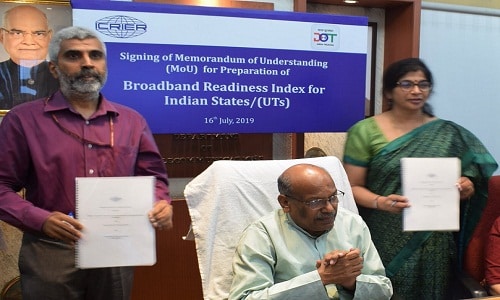On July 16, 2019, Department of Telecom (DoT) and the Indian Council for Research on International Economic Relations (ICRIER) signed a Memorandum of Understanding (MoU) to develop a Broadband Readiness Index (BRI) for Indian States and Union Territories (UTs). Shri. Sanjay Shamrao Dhotre, Union Minister of State for Human Resource Development, Communications and Electronics & Information Technology, Ms. Aruna Sundararajan, Chairman Digital Communications Commission & Secretary, DoT, Shri. Amit Yadav, Joint Secretary, DoT, Dr. Rajat Kathuria, Director and Chief Executive, ICRIER and Ms. Geetha Nair, Secretary, ICRIER were present at the signing ceremony.
Frequency
The first estimate will be made in 2019. Subsequently, it will be made every year until 2022.
Background
The need to develop an initiative was recognized by the National Digital Communication Policy (NDCP) 2018 in order to build a digital communications infrastructure, leveraging existing assets of the broadcasting and power sectors including collaborative models involving state, local bodies and the private sector. It recommended a BRI for States and UTs to attract investments and address Right of Way(RoW) challenges across India.
Functions
- It will assess the condition of the underlying digital infrastructure and related factors at the State/UT level.
- It will provide useful insights into strategic choices made by States for investment allocations in Infocomm Technology (ICT) programmes.
- It will evaluate a state’s relative development and allow for a better understanding of a state’s strengths and weaknesses. It will be adapted and used on an annual basis for systematic evaluation of state-performance on metrics set out as goals for 2022 under the new policy and rank the performances of the states and UTs.
Associations
BRI will be a collaborative exercise with stakeholders including State governments and industry associations like the Tower and Infrastructure Providers Association (TAIPA), the Internet Service Providers Association of India (ISPAI) and the Cellular Operators Association of India (COAI).
Composition
BRI will include 2 parts.
- Part I will focus on infrastructure development based on the measurement of nine parameters.
- Part II will consist of demand side parameters which will be captured through primary surveys. It will include indicators such as percentage of households using computers/ laptops with internet connection, the percentage of households with fixed broadband connection, internet users as a percentage of the population, smart phones density, percentage of households with at least one digitally literate member, etc.
The 9 Indicators of Part I are as follows:
| Sl No | Proposed BRI Indicators |
| 1. | Availability of State Policy on RoW and Towers (based on DoT RoW Rules 2016) |
| 2. | Percentage of ROW cases given permission within 60 days of the first application |
| 3. | Availability of a centralized IT (Information Technology) Portal for ROW clearances across all Government land and building owning authorities. |
| 4. | Adoption of the National Building Code 2016 by the State |
| i. State policy to have enabling provisions for access to government lands and buildings for installation of telecom towers | |
| ii. State policy to have enabling provision for 24* 7 telecom operations | |
| iii. Standardized RFP (Request For Proposal) template for smart city implementation – enabling rules promoting non exclusivity and infrastructure sharing in a non-discriminatory manner | |
| iv. Common duct policy based on the Central Government’s “Dig Once Policy” | |
| 5. | Percentage of mobile towers connected with fibre |
| 6. | Number of fibre kms per sq. KM/ per capita/ per 100 households |
| 7. | Percentage of public institutions / offices connected by FTTX-Fiber To The X (Hospitals including PHCs, Police stations, Schools and CSCs) |
| 8. | Percentage of towers receiving grid supply (Duration: Urban 20 hours; Rural 12 Hours) |
| i. Priority electricity connection available to telecom towers in the state | |
| ii. Supply of electricity at affordable/ industrial rates to telecom towers | |
| 9. | NagarNet –Number of Public Wi-Fi Hotspots in urban areas |
| JanWiFi – Number of Public Wi-Fi Hotspots in rural areas |
About DoT:
♦ Parent Organisation: Ministry of Communications and Information Technology
♦ Founded: 1985
About ICRIER:
♦ Location: New Delhi




